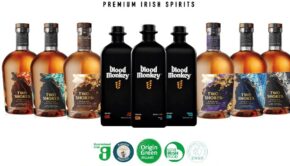News briefs: Wine trade ups and downs, and FindlaterGrant takeover

Whats going up and what's going down in the industry in October, and C&C takes a loss in the sale of FindlaterGrant to DCC
13 October 2008
Wine trade ups and downs
Ups
An interesting innovation from Argentina, Pasitea is a new dessert wine from Francois Lurton’s Bodega Lurton in Mendoza. It’s a blend of pinot gris and torrontes grapes, which gives lots of lush and spicy flavours. Winemaking is somewhat in Italian style, with the pinot gris harvest being sun dried on the ground for several days after picking. Vinification is in oak and there is six months cellar ageing before bottling. Lush on the palate, the wine has a manageable 12.5% alcohol level. Lurton wines are brought to Ireland by Febvre.
A recent wine sale at London auctioneers, Bonhams, has produced a record total for a single fine wine sale there. Over £650,00 was bid for lots that included a case of Chateau Lafite Rothschild 1962 (£18,400), a half case of Petrus 1990 (£12,650) and a case of Taylor’s Vintage Port 1948 (£9223).
Wine buffs will be pleased to note that a wine volume has now joined the series on the 1001 sorts of things you should do before you die. Called, naturally, 1001 Wines You Must Try Before You Die (Cassell, around E27), it contains a mind-boggling 960 pages. A number of the older wines included are now so rare and expensive that you are likely to be, well, dead, before you ever get your hands on them, but the book makes an absorbing browse just the same.
Spain seems to be on something of a roll, at least as far as wine volumes are concerned. Some recent research suggests that Spain’s production will rise to more than 46m hectolitres by 2015, making it the largest wine producer in the world – if the prediction that France will turn out less than 43m hectolitres is also true, that is.
Downs
The financial problems at Australian producer Palandri are not yet ironed out. Deloitte Touche has been handling the administration and the bulk of the company assests have been sold to a Chinese company but it’s far from clear what the final fate of Palandri will be.
Yet more confusion was added to proposed new drinks legislation with the news that, while beers are now to be separated by a barrier from food and other products, wine buyers are to be allowed to browse shelves freely. Unsurprisingly, the brewing sector has protested strongly.
Wine exporting countries have begun to worry about the impact that discount stores such as Lidl and Aldi have had on British and Irish markets since the economic downturn began. While price points at independent off licences seem to be holding firm so far, the average price of wines bought as part of the weekly family shop has begun to decline. This is likely to become more pronounced if the discounters continue to increase market share, as they tend to stock smaller ranges of wines, at lower prices, than conventional supermarkets.
FindlaterGrant takeover
C&C has announced the sale of its wine arm, FindlaterGrant, to DCC. The price is understood to be around E9.6m, comprising E8.1m in company assets and E1.5m for the goodwill. C&C purchased Findlaters in 2001 for E16m and the subsequent merger with its own wine merchant, Grants, was expected to create a superplayer in the Irish drinks trade.
During the last financial year, FindlaterGrant is believed to have broken even on revenue of E33m, net of duty. Although the portfolio has remained sound, some key distributions were lost in recent years, including Penfold’s, Wynns, Wolf Blass, Veuve Cliquot and Krug. According to DCC’s CEO, Tommy Breen, the addition of FindlaterGrant to DCC’s existing wine importer, Woodford Bourne, will create a new force in the Irish wine business, with targeted revenue, net of duty, of around E50m. Certainly, DCC’s multisectional distribution capacity should add strength to the FindlaterGrant operation, which currently employs 32 people. Woodford Bourne has been profitable and DCC is well placed to be extremely cost effective in marketing the combined portfolio.
From C&C’s point of view, FindlaterGrant was no longer a core asset and the company says it has no plans to dispose of any more of its brands. The company has had a rocky year, with cider sales under pressure and the share price, at the time of writing, having slipped to E2.30.



 Print
Print






Fans 0
Followers